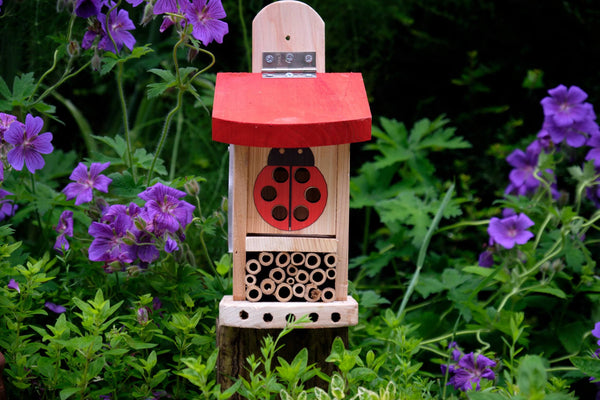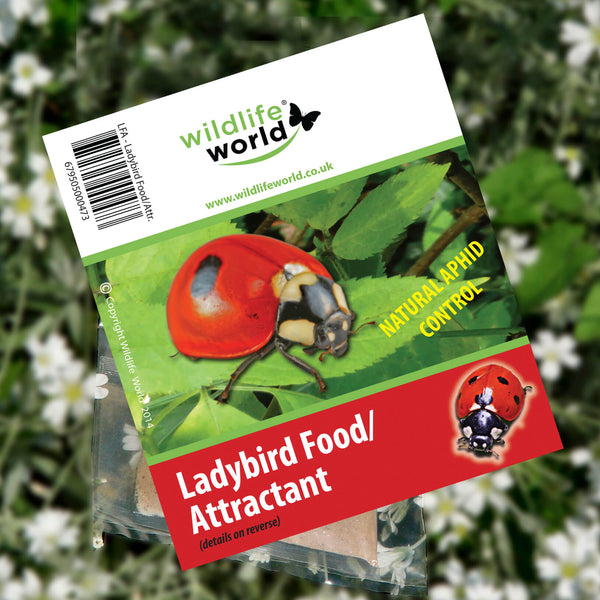About Ladybirds UK - Ladybird Facts & Information
In the UK, there are more than 40 species of ladybird (only 26 of these are officially recognised as Ladybirds) and these familiar beetles can be spotted in woodlands and gardens. Here, the most common Ladybird is the seven spot Ladybird and all Ladybirds belong to the scientific family coccinellidae. The other 20 are known as 'inconspicuous Ladybirds' this means they don't look like other Ladybirds and they lack the vivid colours of other UK ladybirds.

In the UK and Northern Ireland, the introduction of the invasive Harlequin Ladybird has threaten our native species, including the 2 spot ladybird and other species too. The Harlequin Ladybirds eat and out compete native Ladybirds. It's actually one of the most invasive species of Ladybird, and of all other animals too. For context, it took the Grey Squirrel nearly 100 years to spread in the UK - but it took the Harlequin Ladybird only a decade!
Many species of Ladybird do vary in colour patterns, but typically they are brightly coloured and will have either a red, yellow or black body with red spots, yellow spots, white markings or black markings; you might even spot an orange ladybird and they all have black legs. The two common forms are black with two red spots or black with red spots. They do vary in size, but no species of adult Ladybirds are bigger than 12 mm.
For all gardeners out there, Ladybird species are an important beetle to help keep nature healthy. Preying on aphids, scale insects, sap sucking insects and other plants pests, they are highly beneficial to any outside space.
Ladybird Species
Seven Spot Ladybird
This species is one of the most popular species in the UK. It has bright red wing cases and, you guessed it, seven black spots! This is a native species and is often found on plants and deciduous trees.
Two Spot Ladybird
This small Ladybird is red with two black spots. It's often found in large groups on tree bark and in sheltered places.
Harlequin Ladybird
This species is an invasive Asian Species and it is recognised by its varying colour patterns - with the population having red, yellow, orange or black wing cases. It also has black markings.
How Did the Harlequin Ladybirds Invade?
The Harlequin ladybird (Harmonia axyridis), originally native to Asia, was introduced to Europe and North America as a biological control agent against aphids and other pests. It first arrived in the UK in 2004, likely through accidental importation via trade and horticultural shipments.
Its rapid spread across the UK was facilitated by its high reproductive rate, adaptability to various habitats, and broad diet, allowing it to out compete and displace native ladybird species.
Pine Ladybird
The Pine Ladybird (Exochomus quadripustulatus) is a small, native UK species commonly found in pine and coniferous trees. It is characterised by its black wing cases with four distinctive red or orange spots, which give it a recognisable appearance. The two spots nearest its head are comma shaped.
Orange Ladybird
This is a bright coloured ladybird with a distinctive orange coloured case. It has black spots and is often associated with pine trees.
Cream Spot Ladybird
These small, less conspicuous ladybirds have black wing cases with cream coloured spots.
Eyed Ladybird
This is the UK's largest ladybird and it has large black spots on its back that resemble eyes.
22 spotted Ladybird
The 22-Spot Ladybird is a bright yellow with black spots, 22 to be precise. This small, conspicuous ladybird is often found on low vegetation and is primarily a mildew feeder, unlike most other ladybirds that prefer aphids.
Ladybird Lifespan
In total Ladybirds can live up to two years. In their lifespan, they go through several stages including: egg, larvae, pupa and finally adult.
The egg stage lasts around 3 to 10 days, they then become Ladybird larvae for around 3-4 weeks - in this time they grow rapidly and feed on pests.
The pupal stage lasts around 1-2 weeks and this is when the larvae undergo metamorphis, this brings them to their final stage of life: adult hood where they can live up to a year, sometimes longer if they survive the overwinter period.
What do Ladybirds Eat?

The Ladybirds primary diet consists of aphids, and they are well known for helping to control the population! They also feed on other pests including scale insects and mites.
When their primary diet is scarce, a Ladybird in the UK may feed on pollen and nectar.
To attract these beetles into your garden, you can add Ladybird attractant to your bug hotel and allow many ladybirds to naturally control other insects.
Ladybird Breeding Season
To begin the breeding season, tactile interactions take place between female and male ladybirds. This involves pheromone signals. Males approach the females and the pair may touch antennae and move in synchronisation.

Once mated, the females lay eggs in clusters, typically on the underside of a leaf. It's important that it is near an abundant source of aphids as this provides food for the Ladybird larvae.
The eggs are yellow and orange and laid in batches of 10 to 50. They hatch within 3 to 10 days.
Larvae go through several molts as they grow, feeding on aphids and other small pests. This stage lasts about 3-4 weeks. The next stage is pupation, this is where the Ladybird attaches itself to a surface and forms a pupa. Metamorphosis occurs and the larvae turns into an adult ladybird.
Once complete, the adult ladybird emerges from the pupa and begins its life.
Five Facts about Ladybirds
-
The Harlequin ladybird (Harmonia axyridis), an invasive species from Asia, has rapidly spread across the UK, outcompeting many native ladybirds like the Seven-Spot Ladybird.
-
Ladybird larvae are voracious predators, primarily feeding on aphids and other sap-sucking insects, making them beneficial for pest control in gardens.
-
On average, a ladybird lives for about one year, going through four stages: egg, larva, pupa, and adult.
-
Ladybirds are known for their brightly colored wing cases, which serve as a warning to predators. Species like the Orange Ladybird and Pine Ladybird use this coloration to signal their distastefulness.
-
Ladybirds can be found in various environments, from deciduous trees and pine trees to tree bark and sheltered places, where they often overwinter in large groups.








